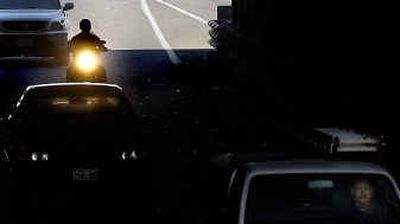Spokane on low end in traffic report

This is one of those surveys where you don’t mind ranking low on the list.
So the good news for Spokane is that the city is on the low end of the Texas Transportation Institute’s annual report on traffic congestion. Spokane ranked 74th out of 85 cities, based on 2002 traffic data – down from 69th last year.
The study is one of the most widely cited traffic reports in the country.
“Spokane does not have a mature transportation system for an urban area of our size,” said Glenn Miles, director of the Spokane Regional Transportation Council.
He added that now is the time to work on adding to that system, because solutions often take five to 10 years to design and implement.
According to the Texas Transportation Institute study, congestion cost the average rush-hour traveler in Spokane an extra $166 and nine hours on the road in 2002.
Assuming all other things remained equal, that dollar figure is sure to be much higher now. Researchers based the 2002 number on an average gas price of $1.48, more than 50 cents less than the average price now, and almost 75 cents lower than peak 2004 prices.
The study doesn’t take into account some of the improvements made along the Interstate 90 corridor in the past couple of years, said Washington State Department of Transportation spokesman Al Gilson.
The state has increased the number of accident alert signs, added incident response capacity to help clear such accidents and has a Transportation Management Center to monitor traffic on the area’s most traveled roads.
“Those are the types of things we do to ease congestion without building additional lanes,” Gilson said.
But the state is also in the process of adding lanes to I-90 east of Spokane.
In addition, construction has begun on a new North Spokane freeway.
Though it may not seem like it to people stuck in Interstate 90 traffic, Spokane is doing better than most similar-sized cities, with congestion here growing at a slower pace.
Spokane’s congestion problems are likely to increase as its population grows, said David Schrank, TTI associate research scientist.
It’s typical for cities to move up in the rankings. Those like Spokane, with delays of less than 10 hours per commuter, could be closer to 20 hours within 10 years, Schrank said.
“There’s no better time than the present to add to the system, so that as growth does occur, you can handle it,” he said.
In the 1970s, Seattle voters turned down a proposal to build a light rail system because they didn’t think it was necessary, said Gilson. Now Spokane transportation officials are examining whether a light rail system should be built here.
And Seattle has been working on its own system at much greater expense than would have been the case 25 years ago.
Traffic in Seattle, of course, stinks. But, believe it or not, according to the Texas study, Seattle congestion is getting a little better. Seattle ranked as having the nation’s 17th worst traffic in this year’s study, down from fifth just two years ago.
Delays there have dropped from 63 hours per year to 46 hours per year for the average rush-hour commuter.
According to the study, Los Angeles still has the worst traffic congestion in the country.
Guess it’s true, just like the song says, that nobody walks in L.A. But with the average commuter there spending 93 hours a year stuck in traffic, it also doesn’t sound like they’re doing much driving, either.